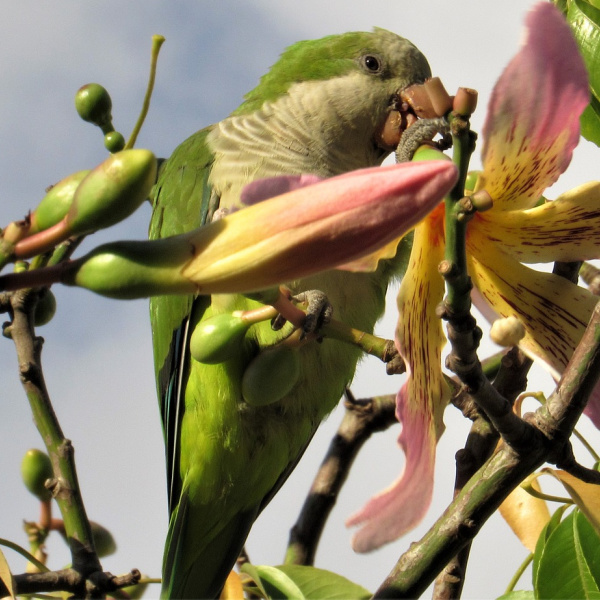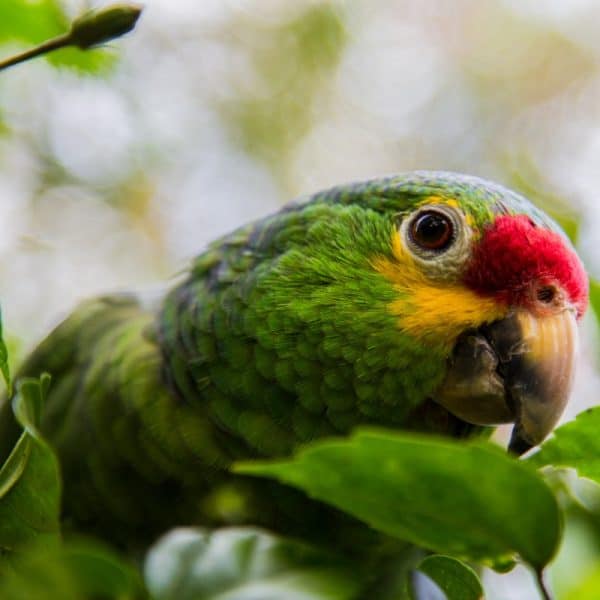
Bird & Parrot Cage Buying FAQ’s
Last Updated on by Mitch Rezman
The WindyCityParrot.com FAQ’s of Cage Buying
|
The cage has to meet not only the requirements of your birds but should blend with your lifestyle. The cage may reside in a casual family room or a formal living room. Maybe you’re lucky (or crazy) enough to have a bird room. There’s a lot of factors and everyone has an opinion.So don’t listen to us. Listen to you. Answer some of these questions and you’ll make a good selection
What Size Cage? Have you heard “buy the biggest cage you can afford”? Nonsense! We know happy well adjusted Macaws living in 30″ diameter round cages. How could they, you gasp? The three Macaws I’m referring to have stay-at-home mom. They are out from 6:00 in the morning till 9:00 at night and are thrilled to go to sleep in their narrow cages. So before you decide on a cage, you need to know what bar spacing to look for: As long as the spacing between the bars is narrow enough to prevent injury if the bird tries to escape. The Bird’s head should not be able to fit between the bars. The door needs to be large enough to comfortably put your hand through, catch the bird, remove the bird, and replace the bird. For larger birds, it needs to be big enough so they don’t rub feathers on the bars every time they turn around. And like people, birds like to stretch (I know an African Grey that does Yoga). Just don’t cramp the bird. Here’s some general guidelines: SMALL: Examples, Finches, Canaries, Parrotlets, Parakeets, Lovebirds: Cage Bar Spacing: No more than 5/8″.Perch Diameter: 3/8″ to 3/4″ MEDIUM: Examples: Cockatiels, Conures, Lories, Senegals. Cage Bar Spacing: 1/2″ to no more than 3/4″ LARGE: Examples: African Greys, Amazons, Macaws, Cockatoos. Cage Bar Spacing: 3/4″ to no more than 1 1/4″. What Species? Small species (Finches, Canaries, Lovebirds and Parakeets) deserve wider cages because birds travel side-to-side. Many of the small species never leave their cages. You have to let them fly because it’s heart healthy. Medium and larger birds have a different set of needs. So let’s apply some common sense. Do you have a big bird? Are you away a lot? Then try to get a bigger cage. (Would you like to spend all day in a room the size of a closet?) Bigger cages allow birds move about much like we move about our home. Ideally parrots like three zones. The upper zone, should have lots of toys and “cover”. Birds feel safe up high, not easily seen, like in the wild. (Don’t we feel comfy in our bedrooms?) The middle zone is where they’ll spend the day, playing with toys, eating, hanging out. The bottom is where they’ll go to look for food and toys that may have dropped. Parrots are scavengers in nature. |
Do I need feeding doors We suggest feeding doors for a couple of reasons. For the smaller birds, its less invasive than sticking a hand in the cage. If you go away for a day or more with a larger bird, feeder door enable “bird sitters” to replace food and water without placing their hands in the cage. What are breeding doors for? Whether you breed or not you can’t keep female birds from laying eggs. You can attach a nest box to your cage over the nest box door opening. This enables the hen to lay and sit on her eggs (whether they are fertile or not) privately as nature intended. What kind of top should the cage have? Flat top – cages will allow play gyms or supplies to be placed up top. May allow for stacking of other cages. Play top – gives the bird a place to be when outside the cage. If you spend time with your bird near the cage, this may be helpful. If you move the bird to another room when he or she is out, a playtop may not be necessary. Convertible cages – Some cages are now designed so the play top can move from room-to-room and then placed back on the cage. Dome top – Allow more height inside the cage. May or may not open. If it opens, it’s hard to hang toys here. Napoleon top – Allow more height inside the cage. May or may not open. If it opens, it’s hard to hang toys here but a perch can usually span the open doors creating a playtop area. Many Napoleon tops have an additional drop down landing style door in front.
What kind of door should I look for? Ideally you should be able to place or remove the bird with room to spare. Large cages will usually have large hinged swing out doors. Many smaller species cages have double doors. A smaller slide up door inside another larger slide up or swing out door making cleaning easier. Drop down or landing doors are useful for flighted birds returning to their cages. Are casters important?
It depends on, the size of the cage, how often you move the cage and the surface the cage sits on. The majority of casters are the type you might see on a modern office chair. They’re made of plastic and have an aluminum shaft that slips into a plug in the bottom of the cage legs. Better cages will have brass casters, with ball bearing swivel assemblies for longer life.
Powder coat, paint or stainless? There is no easy answer. A good paint coating will outlast a poor powder coating. Stainless steel is harder to weld than wrought iron. Low quality stainless steel can rust. The cage manufacturers we offer have been chosen by us for their overall quality, attention to detail, replacement parts availability and high levels of customer service. We try to include as much information about each cage as possible. We plan on enhancing our listings with even more information and better images in the coming weeks. Thank you for your patience. If you have a question, call toll free – 877.287.0810.
|
Author Profile
Latest entries
 The Traveling BirdJune 26, 2025Can You Name 5 Parrot Species That Are Living Wild in the USA?
The Traveling BirdJune 26, 2025Can You Name 5 Parrot Species That Are Living Wild in the USA? Bird BehaviorJune 26, 2025How is it Parrots Are Problem Solvers Social Animals and Even Use Tools?
Bird BehaviorJune 26, 2025How is it Parrots Are Problem Solvers Social Animals and Even Use Tools? Bird & Parrot AnatomyJune 25, 2025How a Tiny Chemical Modification Makes Parrots Nature’s Living Paintings
Bird & Parrot AnatomyJune 25, 2025How a Tiny Chemical Modification Makes Parrots Nature’s Living Paintings PigeonsJune 20, 2025How Do Parrots Thrive in Cities Outside Their Native Habitats?
PigeonsJune 20, 2025How Do Parrots Thrive in Cities Outside Their Native Habitats?


